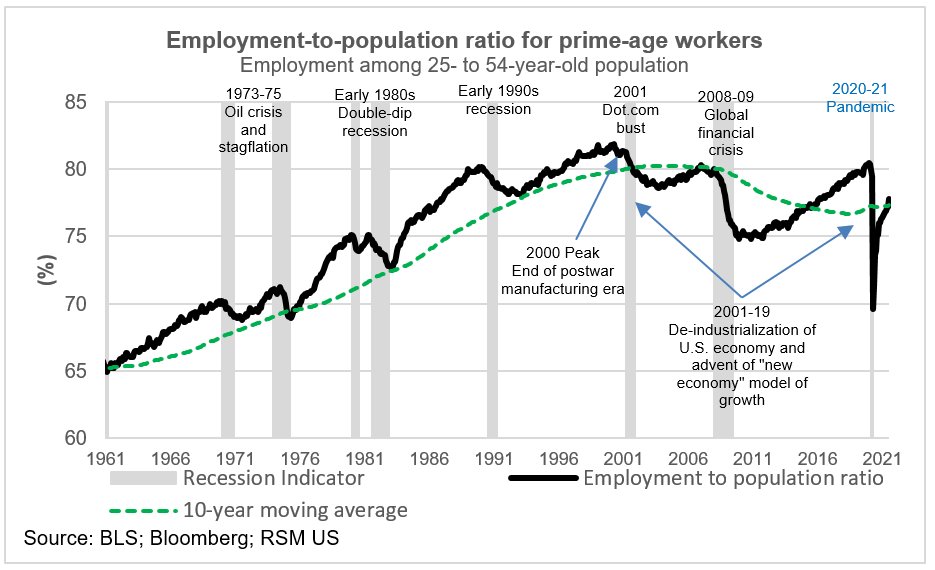August jobs report preview: Expect a hint of delta drag on hiring

We expect an increase in total employment of 600,000 in August with the chance of a stronger number linked to seasonal hiring in education when the jobs report is released on Friday.
We expect an increase in total employment of 600,000 in August and the unemployment rate to decline to 5.2%.
That seasonal hiring will add roughly 225,000 jobs to the top-line number, while the unemployment rate will decline to 5.2%. Average hourly earnings should increase by 0.3% on a month-over-month basis and by 4% on a year-ago basis.
Those seasonal adjustments around educational hiring will almost certainly be the swing factor and the primary risk to our top-line forecast. The pandemic dynamics around the seasonal adjustments at the Bureau of Labor Statistics remain quite strong and could very well result in a much faster pace of hiring than that implied by our forecast.
For that reason, we do not expect that the Federal Reserve will alter its rhetoric aimed at shaping market expectations of slowing its monthly asset purchases; we expect that to be announced in November and start in December. In fact, we think that an outcome near our forecast for the jobs report would underscore the expectations that central bankers have been working hard to shape.
Our baseline forecast is predicated on the drag that the delta variant is having on the economy. We can observe this dynamic in a range of alternative data that we use to formulate our forecast, and also in the easing in manufacturing sentiment in the United States and around the world.
Those are the primary reasons that our forecast of a 600,000-job gain for the August employment report came in well below the consensus of 748,000. We would make the case that a slower, albeit still robust, pace of hiring occurred in August as firms had problems finding workers amid the delta variant’s spread.
We fully expect that as the delta variant crests, which it may be doing, the pace of hiring will remain strong throughout the remainder of the year. The major drivers of hiring will be leisure and hospitality, education, goods producing and business services.

One potential wrinkle in the data that may add a bit of confusion could be another robust month of people re-entering the labor force inside the Bureau of Labor Statistics’ household survey, which is used to estimate the official unemployment rate, in contrast with the establishment survey, which is used to estimate the top-line change in total employment.
The household survey may look somewhat more robust as those who work as independent contractors return to work based on sustained demand for labor and the end of pandemic-related unemployment insurance in 26 states over the past three months.
The remainder of the states will withdraw pandemic-related unemployment benefits in September; the ending of benefits in those states will not play a role in the August report.
This is why the return of prime-age workers, or those 25 to 54, remains the key metric in ascertaining the overall health of the labor market. In particular, over the next few months the return of women without college degrees and minorities in that cohort will most likely be the decisive factor in the return to full employment, which the central bank is monitoring as it considers when to begin its tapering operations.
Special survey questions
In addition, we are focusing on internal estimates of the BLS that will not appear in the first round of the headline data but may tell the story of why hiring slows. This supplemental data comes from questions added to the household survey beginning in May last year to gauge the effects of the pandemic on the labor market. Some of the key questions include:
- How many people cannot work because the pandemic forced their employer to close?
- How many workers received at least some pay from their employers for hours not worked because of the pandemic?
- How many people were prevented from looking for work because of the pandemic?
This supplemental data is not seasonally adjusted.
There will be no impact from Hurricane Ida in the August jobs report. That will be a September story that will provide an interesting interplay with the other labor market dynamics such as those workers re-entering the workforce as schools reopen and as unemployment insurance is withdrawn.
The first hint of Ida’s impact will appear in the jobless claims data for the week ending Sept. 4, which will be released on Sept. 9, and then in the following week’s data.
For more information on how the coronavirus pandemic is affecting midsize businesses, please visit the RSM Coronavirus Resource Center.
